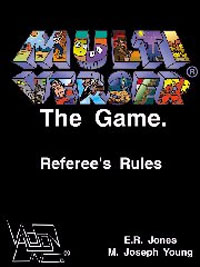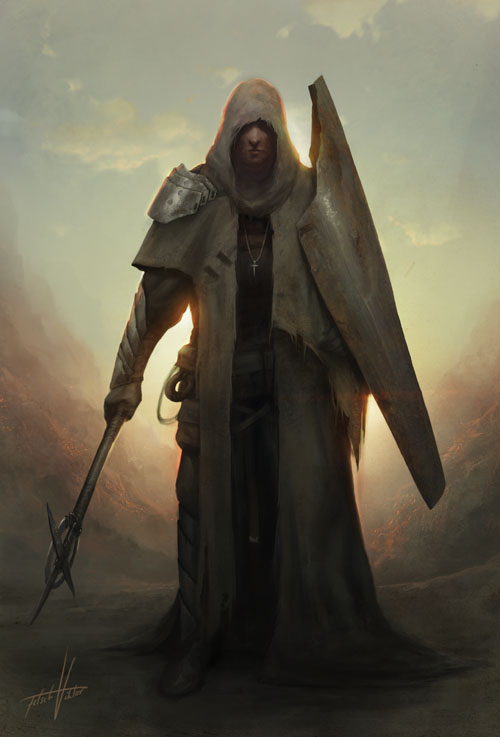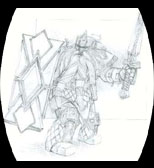Tagline: It’s FUDGE. It’s the 1st edition DMG. It’s a campaign. It’s not great, but it’s not bad. It is worth the money.
This review requires a bit of history to put it into its proper context.
Multiverser became the first game to become an official RPGNet Pariah, a status which actually originated on various Usenet groups. Basically, the game was released, the creator pitched it as the greatest thing since sliced bread (using basically all the same rhetoric you’d expect from a fantasy heartbreaker), and was then sandbagged by the internet.
Hilariously, one of the biggest complaints was that they were charging $50 for the core rulebooks. $50! (This was hilarious partly because this included two books totaling 710 pages, and even in 1999 $50 was hardly an outrageous or unusual price for that. In retrospect it’s even more hilarious, because within a couple years the entire industry was finally forced to accept that they had been undercharging for their products for at least a decade and $50 core rulebooks became relatively commonplace.)
In response to the sandbagging, Mark Young, the creator of the game, asked for reviewers. I volunteered. He sent me a digital copy of the rules. This is what I found…
 Note 1: It is important to note right up front that the price of $50 represents not only the core Multiverser rulebook, but also a volume called The First Book of Worlds. This review only deals with the core rules. A future review will deal with The First Book of Worlds.
Note 1: It is important to note right up front that the price of $50 represents not only the core Multiverser rulebook, but also a volume called The First Book of Worlds. This review only deals with the core rules. A future review will deal with The First Book of Worlds.
Note 2: Secondly, I want to explain how this review came about. It sprang from a series of debates regarding the Multiverser system which took place on the Usenet newsgroup rec.games.frp.misc. Following the debate several people, including myself, stepped forward to offer reviews of the system in order to prevent some solid facts regarding the system in a debate which had otherwise consisted largely of unfounded supposition versus extravagant claims. Valdron, Inc. provided me with an electronic review copy. Valdron, Inc. did not solicit this review; nor do I feel in anyway indebted to them – but you deserve to know from whence the review came.
The first thing I should say regarding this game is that it was extremely difficult to get a grasp on it in order to review it. With most games that I review its relatively simple to quickly catch onto what the system and setting are attempting to do and then proceed from there. With Multiverser I had an amazing amount of difficult doing this. I think this is because I had some extremely incorrect expectations coming into this game, and then had to completely change my POV before it began to make sense.
Here, then, is my conclusion:
Multiverser is a campaign game wrapped up in an extremely complicated system which is a fascinating mixture of FUDGE and the 1st Edition AD&D DMG. It is completely unlike anything I’ve seen before – and that either means its a game perched on the edge of breakthrough success, or instant obscurity. It’s not for everyone, but it just might be for you.
IT’S A CAMPAIGN, STUPID
The first, and biggest, breakthrough for me was the realization of exactly what this game was attempting to be. The title and various discussions concerning the system had completely mislead me into believing that Multiverser was a generic gaming engine in the spirit of GURPS, Hero, and others. It took me nearly fifty pages before I realized this wasn’t what their goal was at all – rather what was being presented was a very basic, very broad multi-genre campaign in the spirit of Sliders or GURPS Alternate Earths.
What distinguishes this particular campaign is the idea of scriff – possibly the most original and thought-provoking concept I personally found within the covers of the book. The basic idea is that all the PCs are imbued with a substance known as scriff. The concept of scriff makes Multiverser possibly the only RPG on the market where the PCs are expected to kick the bucket on a regular basis – because whenever they do so they reappear in an alternate universe. This mode of play obviously has certain drawbacks (for one thing no long-term development of setting or NPC interaction), but these are common limitations of the dimension-hopping genre.
Another interesting facet of this campaign is that Multiverser positively goes out of its way to encourage the GM to have the players split up – reawakening in separate universes – before finally reuniting together in a single universe after several side-trips. This, of course, makes for much more difficult campaigns to run – but Multiverser states right up front that this game is not for amateur GMs and that this concept, in particular, is much more difficult to run than a standard RPG environment where all the PCs stick together. In many ways I was reminded of the type of campaign described in the Amber Diceless Roleplaying System. There is, of course, no requirement that you play your games in this manner – although I would then suggest figuring out some reason why the players always seem to appear together and go places together. You will also need to define a much tighter plot since it will be necessary to kill off all the PCs in a fairly narrow section of time in order to have them all be in the same place at the same time.
A far more nebulous decision for the campaign comes in the form of having the players play themselves. Although I have known some campaigns based on this premise to work, these success stories are vastly outnumbered by horror stories – particularly of the variety wherein the GM doesn’t seem to think that Joe Average Player is as intelligent as Einstein. The decision to stress this as a campaign necessity, rather than simply an option, is even more puzzling considering that character creation is entirely descriptive – you assign whatever you feel to be appropriate without worrying about points, classes, levels, or other balancing mechanisms. This is so completely easy to ignore, however, that is little more than an irritating artifact.
FUDGE?
Reading my summary of the system probably left many of you with a serious question: “Wait a minute, its a complicated system which is like FUDGE? Is that even possible?”
Well, not quite. But the methodology is more than slightly similar: Provide a basic system which can be extrapolated, changed, and added to as the GM sees fit. Of course with a complicated system its a far more difficult to “fudge” things than in a simple system like FUDGE, but the Multiverser designers more than compensate for this by providing you with a wealth of options as well as a peek into the game theory which went into designing the system.
To give you an idea of the type of material included let me point towards Appendix 3: Basic Dicing Curves. This Appendix deals exhaustively with how the probability curves of dice work. This information is provided because the central resolution mechanic is designed in such a way that the GM is expected to modify the type of dice used to resolve an action, in order to obtain precisely the result they want.
Sound familiar? It should. FUDGE uses an identical methodology. Of course FUDGE’s system is so simple that it’s not necessary to explain probability distribution. I, personally, prefer FUDGE, but it is also easy for me to see how the Multiverser system could hold appeal – it has a precision which the extremely low granularity of FUDGE will never possess. This precision, of course, comes at the cost of complexity – and you should ask yourself which compromise you want to take.
FIRST EDITION AD&D?
Another question which probably sprung to your mind was, “The First Edition DMG? And you think this is favorable review?”
In short: Yes.
One of the things which came out in the discussion on rec.games.frp.misc was that the Multiverser designers considered the DMG1 to be one of the greatest gaming manuals ever produced. This naturally baffled quite a few people, myself included. It was only once I saw Multiverser that I understood why they had said that and why they believe that.
First, you won’t find much artwork in this book. The thing is 515 pages long and all but a dozen or so of those are packed full with words and nothing else. Those of you who have been bemoaning the rise in art-content in books to the detriment of practical gaming content would rejoice to see that the Multiverser creators have embraced this spirit as well. Information is what the gamer needs, the thinking goes, and information is what we’ll give him.
In fact, the only art in the book is a full-page piece at the top of each chapter. If you’ve seen the art in the 1st edition of AD&D you’ll know what to expect – plain ink drawings, with often humorous content (my personal favorites include the robotic hand dropping a set of dice into a three-fingered alien palm, and the two pilots sitting next to their crashed ship of fantastic technology attempting to light a fire by rubbing two sticks together).
Second, as I’ve said before, this book is packed with information. Sure we all laugh at Gygax’s Table of Courtesans, but some of the stuff in the DMG1 was invaluable for those who like having a separate, specific rule to cover everything. The Multiverser designers, again, took this to heart. Again, it’s not a style I personally enjoy – but it is a style I can easily appreciate the appeal of.
Multiverser of course does this without adopting Gygax’s atrocious and opaque prose style.
$50?!?!?!
The biggest concern, by far, concerning the Multiverser system is the price tag – you have to spend $50 to get the basic book.
$50?!?! Forget it, right?
Well, first realize that the basic book isn’t actually $50. Included in that total is the First Book of Worlds, which (as its title suggests) contains several different worlds which your players can travel to. The reason you can only buy these two books together is because the Multiverser team feels very strongly that everything you need to play a game should be found in one book – and although they couldn’t print everything in one book for various reasons, they thought they could at least include it under one price tag.
Personally I think they’re nuts. It’s a good philosophy, but frankly everything you need to play Multiverser IS in the core book and the First Book of Worlds strikes me as completely optional. They should separate the package and, thereby, lower the price to a level where gamers would feel much better about sending money to them in order to try their game system. This become even more true since you can’t get Multiverser in stores to my knowledge, only through mail order.
To be fair in judging the value of the core rulebook though, let’s judge it at a cost of $25 (split it evenly right down the middle between the two books). Is Multiverser worth $25?
The answer is, “Hell yeah!” If nothing else this system is exhaustive in the detail and options it provides – providing ammunition and material for other games you may choose to run. Of particular use, I’ve found, is the aforementioned Appendix 3 – which very nicely summarizes probability theory concerning dice and allows easy calculation of the probability spread in any system you might choose to run.
Compare the densely packed text of these 515 pages to the $30-$35 game books that are coming out now from other companies, and you can clearly see that if nothing else, you’re getting your money’s worth.
(I will be reviewing the First Book of Worlds at a later date when I have had time to more properly study it. Allow me to state again that $50 for this two book package is not at all a bad price when compared with the rest of the industry. For example if you look at Heavy Gear (one of my favorite systems) a comparable purchase there would be the core rulebook and the Life on Terra Nova sourcebook, a combined total of approximately $55.)
A FEW SUGGESTIONS
All that being said, Multiverser does possess a rather sizable flaw and it’s a flaw which is large enough to suggest that a second edition of this game would be well advised. My suggestions if such a thing were to ever come to pass:
1. As mentioned before, drop the “play yourself’ requirement from the rules. At most offer it as a suggested method of play, but also include other suggestions.
2. The book is in need of reorganization. Clearly delineate your various ideas into separate, distinct sections. This need is particularly poignant since the primary strength of the system, in my opinion, is the way in which you can mix-and-match elements.
3. Clarify your system mechanics. They are good mechanics and achieve what they are aiming for, but they also vaguely expressed in some places.
A further suggestion which might be immediately implemented, and has already been implied, is that you begin selling these books separately. There’s no real need to mandatorily sell them together, and I believe you are doing nothing but injuring your sale potentials by marketing the books in this fashion.
SUMMARY
The quick-and-dirty summary of this product?
The content is great, the lay-out and presentation need some work (although there’s nothing wrong with the information-heavy approach, clarification and distinction is particularly needed considering how much material is present). This system is not for those who dislike complicated systems – you will absolutely hate it. Those who do like more complicated systems will, however, find a plethora of ideas to use elsewhere even if they don’t like the system itself.
Style: 2
Substance: 4
Author: E.R. Jones and Mark Young
Company/Publisher: Valdron, Inc.
Cost: $25 ($50 for both books)
Page count: 551
ISBN: n/a
Originally Posted: 1998/09/25
At the time, this review seemed to have the effect of quashing Multiverser’s pariah status. I don’t think it won the game any particular fans, either, but people stopped treating it like a trampoline. (So it served a kind of inverse function to Darren MacLennan and Jason Sartin’s review of F.A.T.A.L., which righteously ensconced that game into a private hall of eternal infamy.)
Looking back, I’m somewhat bemused by my discussion of the 1st Edition DMG. At the time, it really was basically impossible to find anyone online who would profess any particular love for that book. It really is remarkable the degree to which (a) 3E rehabilitated D&D’s online reputation and (b) the OSR has rehabilitated that book in particular. My own opinion of the book has grown a little fonder in light of its assistance in stocking my OD&D hexcrawl, but is largely unchanged: A lot of useful stuff in there, but the idea of trying to actually run a game from that disorganized morass is completely abhorrent to me.
Multiverser still sits on my shelf today. Much like the 1st Edition DMG it is a treasure trove of nifty utility which I value but will never actually play. I can’t actually recommend it in good faith. But what I can recommend whole-heartedly is The First Book of Worlds. That review, however, will have to wait until another day…
For an explanation of where these reviews came from and why you can no longer find them at RPGNet, click here.
 Technoir continues to be a big hit at my game table. It’s proven to be a success not only with my hardcore players, but also with the casual brigade. The question now is whether it can be bootstrapped into either an open table of some sort or settle down into a dedicated group. (We’ve had a few thoughts on both.)
Technoir continues to be a big hit at my game table. It’s proven to be a success not only with my hardcore players, but also with the casual brigade. The question now is whether it can be bootstrapped into either an open table of some sort or settle down into a dedicated group. (We’ve had a few thoughts on both.)


 My next PC:
My next PC:










